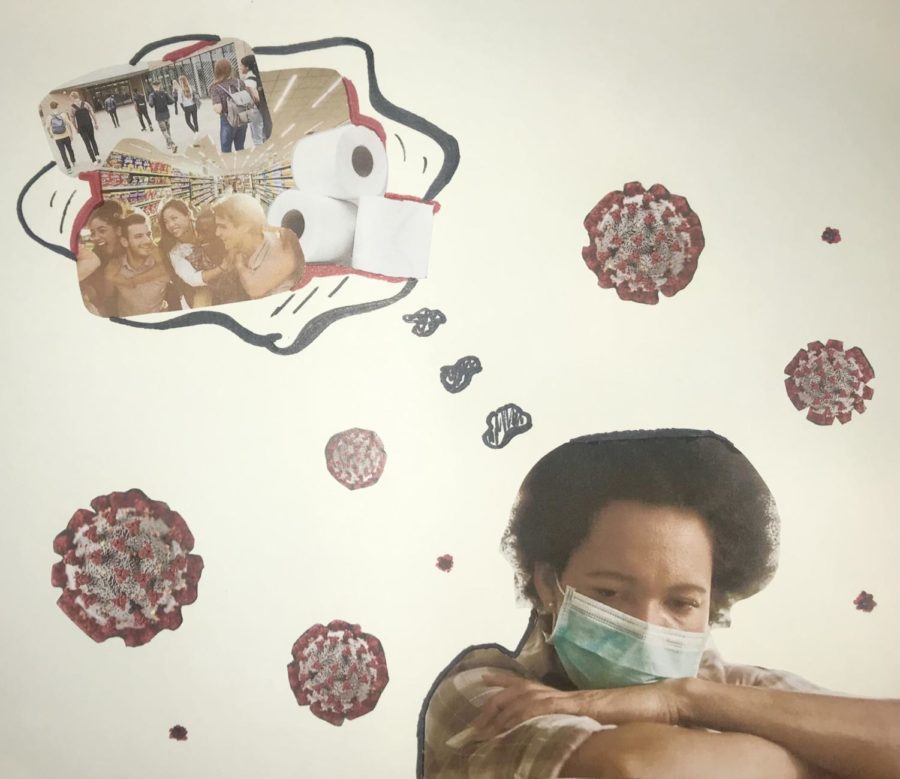Normal is Now Abnormal
Everything that we once considered customary now feels foreign after a year of coronavirus restrictions.
Imagining what the future holds is now more difficult than ever.
March 25, 2021
Just over 365 days ago, our lives were flipped upside down and inside out. All of a sudden, school was cancelled for “two weeks,” people were walking around with masks on, empty shelves lined every aisle at grocery stores, and toilet paper vanished off the face of the Earth. For most people, this extreme change was the greatest level of abnormal that they’ve ever experienced.
Though it may be difficult to comprehend, it has been approximately one year since the COVID-19 pandemic took our world by storm. One year is a long time, a long enough time to adjust to what used to be perceived as “abnormal.” Only being able to see someone’s eyes above their mask and constant Zoom calls are common aspects of our daily lives now.
As we transition, however, into an improved state throughout the spring and summer with the vaccine rollout, what we would have considered normal a year ago will start to reappear. A similar drastic transition will occur again. Our once beloved normal will become the abnormal. As abstract as it may seem, that concept presents an interesting question on how we will proceed in this process.
The transition into the pandemic occurred so quickly and frantically compared to the slow transition that we’re undergoing right now, back to our once normal state.
Adaption is a critical aspect of human tendency. We have an instinct to adapt to new situations and surroundings. This is obviously prevalent throughout history. But, more and more, we have developed this tendency to resist change and adaptation. We get stuck in our ways and refuse to give up our sense of normal.
With the pandemic, we were almost forced to adapt due to the large scale of change that was occuring. But, now we have been in this new adapted state for over a year, and there’s still dangers that aren’t totally gone. Our desire to adapt again in such a short period of time is low.
Not to mention, we’ve gotten so used to wearing face coverings, staying six feet apart, and having online meetings, that changing back to a state that we yearned for so badly a year ago is foreign.
Schools have started phasing students back to in-person instruction, mask mandates are starting to be lifted, and more businesses are opening up. All this is abnormal for us even though it’s what we’ve experienced for the majority of our lives. Any change is abnormal even if we’ve lived in that change before.
Many would assume that going back to a normal state would be easy and natural for society to do. Yet, even in the small ways we’ve returned to life before the pandemic, we have already discovered that it’s strange.
One troubling question that arises from this realization is, are we, as a society, going to be able to fully get back to our once normal state if it is so abnormal to us now?
The hope is that yes, of course we will get there, but how ideal is that notion? Is it too optimistic to believe that we will be able to experience a functioning normal again? Normalcy will look different than what we remember it as.
We have to keep that in mind as we get closer to returning to our lives before the pandemic. Another round of adaptation has to happen, and we all know that takes time. Expecting an easy transition is unrealistic.
We will get there. It may not be exactly how we remember it, but moving towards an improved state, now matter the new appearance, is progress. Accept the abnormalcy of our normal.













Michelle H • Mar 25, 2021 at 6:11 pm
Such an honest and thoughtful, yet hopeful piece. So good anna!